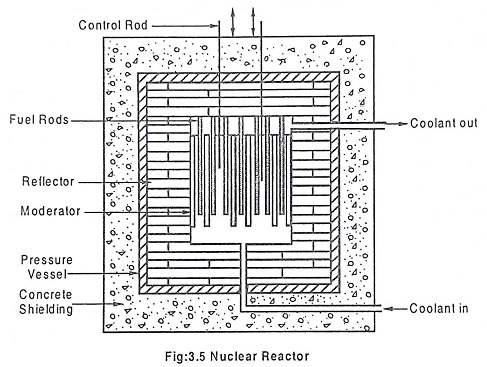Nuclear Reactor – Definition and its Components:
Nuclear reactor is an apparatus which is used to extract the heat produced by the nuclear fission chain reaction. In other words, a nuclear reactor is a controlled chain-reacting system supplying nuclear energy.
Mechanism of heat production
The fission fragment after bombardment with the nucleus move at high speed. However, they slow down because of dense mass of metal, they are rapidly slowed down and brought to rest by colliding with another atom, thus the energy is converted into heat.
The components of nuclear reactor are shown in Fig. 3.5.
- Nuclear fuel
- Moderator
- Control rods
- Reflectors
- Reactor vessel
- Biological shielding
- Coolant.
1. Nuclear fuel:
Nuclear fuel should be fissionable material. While the nuclei of the fuel is caused to undergo nuclear fission by nuclear bombardment, it should produce fission chain reaction. The nuclear fuels generally used in reactors are U235, Pu239 and U233.
2. Moderator:
Moderator is used to slow down the velocity of neutron. It reduces the kinetic energy of fast neutron to slow neutron. The chain reaction can be maintained by the slow neutrons when the ordinary uranium is used as fuel. The graphite, heavy water (or) beryllium are used as moderator with natural uranium. The ordinary water is used as moderator only when the enriched uranium is used. But enriched uranium is costly due to various processing needs.
3. Control rods:
Since the amount of energy (heat) released is enormous, a high control is necessary to prevent the melting of fuel rods, disintegration of coolant and destruction of reactor. The controller rods are in the cylindrical (or) sheet form and is made up of cadmium, boron (or) hafnium. These control rods are moved in and out of the holds in the reactor core assembly. If the controls rods are moved in, then they absorb more neutrons and damp down the reaction and their with drawal absorb less neutrons. Thus power of reaction is controlled by moving the control rods in and out.
4. Reflectors:
The reflector is made up of graphite and beryllium. The reflector is used to send back the neutrons into the core resulting in minimization of neutron losses. The neutrons released during the fission process will be partly absorbed by the fuel rods, moderator, coolant (or) structural material. Some neutrons which are unabsorbed will try to escape from the reactor core and they will be lost for ever. In order to reduce these losses, the reactor inner surface is coated with reflector which reflects the escaping neutrons backs to the core. Thus the reflector is used to conserve the neutrons as much as possible in order to reduce the consumption of fissionable material and to keep the size of the reactor small.
5. Reactor vessel:
The reactor vessel is used to enclose the reactor core, reflector and shield. The coolant is passed through the passages provided in the reactor vessel. The maximum pressure in the reactor vessel can go upto 200 bar. The control rods are inserted in the holes provided in the reactor vessel. The fuel and moderator assembly i.e. the reactor core is normally located at the bottom of the reactor vessel.
6. Biological shielding:
The radiations like α rays, β rays and γ rays from the reactor are very harmful to human life. It is very much important to absorb these radiations to prevent the danger resulting from these. The radiations are absorbed by the lining of steel plate and gets heated. Thick layers of lead (or) concrete are provided all round the reactor for stopping the gamma rays. Thick layers of metals (or) plastics are sufficient to stop the alpha and beta particles.
7. Coolant:
Coolant flows through the reactor core. The large amount of heat produced in the reactor due to fission of the nuclear fuel are transferred by the coolant.
The coolant transfers heat taken from the reactor to another medium (or) some time water will be acting as coolant. In this case, water gets heated up and converted into steam and the steam is sent to the turbine to produce power.
